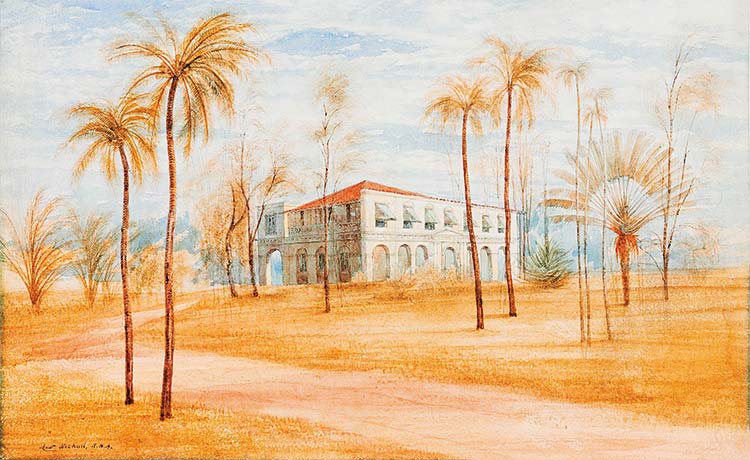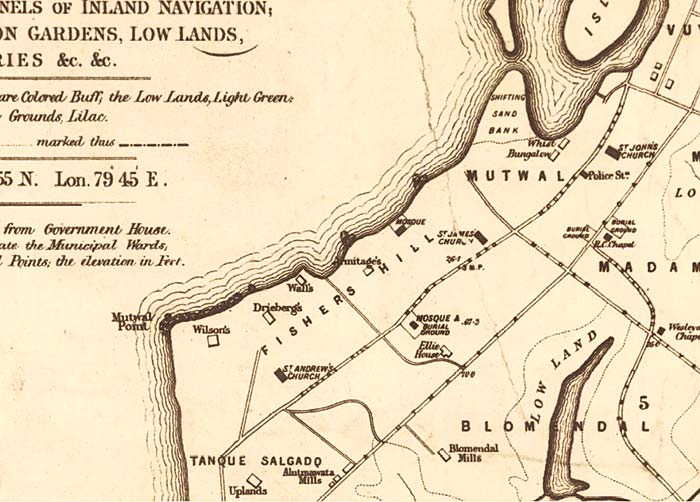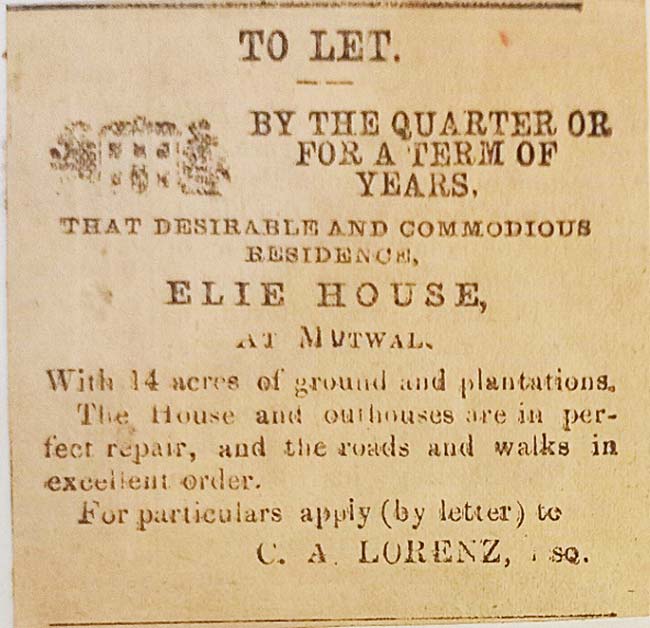Old Mutwal, Elie House and Lorenz-By Avishka Mario Senewiratne
Elie House, water colour by Andrew Nicholl
avishkamario@gmail.com
Source:Island
The history of this most historic and valuable abode Elie House dates back to the days of Philip Anstruther, the Colonial Secretary of Ceylon from 1833 to 1845. Anstruther was a capable Civil Servant, who won the popularity of both the home Government and the inhabitants of Ceylon. Capt. James MacDonald Henderson states in his book The Rebellion in Ceylon, “Had this gentleman [Anstruther] but retained his appointment of Colonial Secretary, there is every reason to believe that the rebellion of 1848, with its long train of miseries and misfortunes, would never have occurred”.
Due to his physical defect, Anstruther was widely called the “one-armed Rajah” by the English and as “Ath-Kota-Rajuruwoo” by the Sinhalese. During his tenure, Anstruther lived in the mansion of Elie House in Mutuwal. He had purchased this property of three and a half acres for 300 Rix dollars. A few years later, Anstruther named the abode Elie House in honour of his grandfather, who was the Third Baronet of Elie House in the County of Fife. In his monumental book Ceylon (1859), James Emerson Tennent, who succeeded Anstruther as Colonial Secretary as well as the owner of Elie House, describes the mansion as follows:
“It stands on the ridge of a projecting headland, commanding a wide prospect over the Gulf of Manaar; and in the midst of a garden containing the rarest and most beautiful trees of the tropics, tamarinds, jambus, nutmegs, guavas, mangoes, and oranges, the graceful casuarinas of Australia, and the beautiful traveller’s palm of Madagascar.” (Volume II, p. 64)
Though Sir Emerson Tennant lived in Elie House during his tenure as Colonial Secretary, the ownership of the house remained with Philip Anstruther who lived in London. Tennent’s trusted Irish artist friend, Andrew Nicholl was a regular visitor at Elie House. His watercolour painting is perhaps the only surviving illustration of Elie House. Many years after Tennant returned to England, Anstruther realising he had hardly any business left in Ceylon sold this house to Mrs. Angela Brown in 1857. A year later, in 1858 She sold Elie House to C. A. Lorenz for £2,500 when the exchange rate for a pound was just 10 rupees. During this time, jon the outskirts of Elie House, there was a property called Elie Cottage. Lorenz’s friend and fellow Legislature, George Wall occupied this house. Wall had lived in Elie House for some time before Lorenz purchased it. Annexing the adjoining properties, Lorenz extended the grounds of Elie House to over 14 acres. A variety of tropical fruit trees, some imported from Singapore by Anstruther adorned the gardens of Elie House.
The Ghost of Elie House
A hitherto unknown event occurred in Elie House on one particular night in May 1863. It was midnight and all the occupants were fast asleep. Lorenz had allowed various people such as his nephews, nieces and friends to live in the many vacant rooms of Elie House. According to Blaze, no fewer than 11 of his nephews and nieces made Elie House their permanent residence. (Blaze, p. 225) It is said that a mysterious figure appeared at the foot of a bed on which a lady was sleeping in one of the principal bedrooms. The sleeping lady woke up to notice this figure of an old man steadily looking at her for a few seconds and then silently moving away and disappearing through an open door.
The next morning the news spread like wildfire and everyone was intrigued by this ghost story. Lorenz in particular was curious to identify who this person may have been. Thus, he calmly questioned the lady and she surprisingly related the features of the figure quite descriptively. Still unable to determine who it may be, Lorenz decided to show her a set of photographs of famous people, so she may perhaps identify the ghost.
Some portraits were borrowed from Sir Richard Morgan (who lived in Whist Bungalow, Mutuwal) for this quick investigation. After Lorenz placed the pictures on the billiards table, he asked the lady to see if she could identify her visitor. Without any hesitation or delay, she picked up one portrait and pointed out that she saw the person depicted in that illustration. This was Philip Anstruther. Lorenz was baffled as to why she saw a man who still lived in London. However, when inquiries were made it was found that Anstruther had died in London the same day he appeared to the lady in Elie House! Perhaps, his spirit was more in Ceylon than in his native country. (cf. Ceylon Causerie, August 1933, p. 17)
The ghost continued to flit through Elie House. J. B. Siebel, a childhood friend of Lorenz related the following story to one of the local papers in 1916.
“In this connection, L related to me a ghost story. Not being able to sleep one night, he walked downstairs with his briefs into his office and kept on reading them till the small hours of the morning when he fell asleep from sheer exhaustion with his head on the table. A cold, creepy sensation across his back woke him, and “on my honour”, he added, “I saw old P-pass by me and the hair of my flesh stood stiff. As I opened my eyes very wide thinking it was all a dream, I observed the door behind me ajar. I had forgotten to close it and the cold air, as well as the ghost, had come in through that and had given me that creepy sensation. When morning dawned the servants turned up and they swear they saw the Ath-Kotte-Rajuruwoo (the short-handed chief) go through the house at the time at which the ghost had appeared to me.” (Quoted from the Ceylon Causerie, September 1933, p. 15)
1893 Map of Colombo depicting Elie House and its environs (SLNA – Col 53)
Advertisement published in The Ceylon Examiner on March 22, 1871
Elie House
was always full of people. Many had come from distant areas for their business with Lorenz. Plenty of carriages were parked around the premises. It was certainly a busy spot in its day. Lorenz welcomed people of all strata and his house was a haven for those who came down to relate their grievances. Siebel in his writings mentions that on one of his visits to Lorenz in Elie House, he saw hundreds of men gathered outside to thank and praise the latter for many of the favours he had bestowed upon them. Many of those people were Sinhalese.
There was a stone at the entrance of Elie House with the inscription “Stads Waght A 17020“. It is believed that Lorenz picked it up when the Dutch Fort in Colombo was dismantled. Lorenz would live in Elie House till early 1871 and would die that very year in his last abode Karl’s Ruhe. The property was soon put for sale and was purchased by Mudaliyar Samson Rajapakse, who paid Rs. 33,000 for it. His son, Gate Mudaliyar Tudor Rajapakse inherited it upon his death in 1888.
Tudor Rajapakse, one of the country’s richest men at that time, rented this house to Maha Mudaliyar Sir Solomon Dias Bandaranaike. It was in Elie House that Maha Mudaliyar’s son and future Prime Minister S. W. R. D. Bandaranaike was born in January 1899. (Bandaranaike, Sir S., (1929), Remembered Yesterdays, p. 82)
In his memoir, Sir Solomon reveals that John Rodney and Captain Bayley were occupants of Elie House before his time. In 1902, the Government announced that a supplementary reservoir for Colombo was to be made through Mutwal and Elie House had to be demolished. For this reason, the Government purchased Elie House from Tudor Rajapakse for the cost of Rs. 151,000. Sir Solomon, who had to vacate Elie House that year commented on it as follows: “It (Elie House) stood in a splendid position, as anyone who walks in the Park today can see, and the structure itself, of which not a vestige remains, consisted of a solid building with twin towers that gave a unique view of the harbour and docks.” (Remembered Yesterdays, p. 114)











